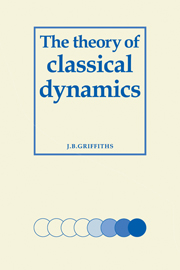Book contents
- Frontmatter
- Contents
- Prefaces
- Introduction
- 1 The Newtonian method
- 2 Space, time and vector notation
- 3 Force, mass and the law of motion
- 4 Newtonian relativity
- 5 Newtonian gravitation
- 6 Particle dynamics
- 7 Systems of several particles
- 8 Rigid body dynamics
- 9 Analytical dynamics
- 10 Variational principles
- 11 Hamilton–Jacobi theory
- Appendix list of basic results and definitions
- Suggestions for further reading
- Index
11 - Hamilton–Jacobi theory
Published online by Cambridge University Press: 25 October 2011
- Frontmatter
- Contents
- Prefaces
- Introduction
- 1 The Newtonian method
- 2 Space, time and vector notation
- 3 Force, mass and the law of motion
- 4 Newtonian relativity
- 5 Newtonian gravitation
- 6 Particle dynamics
- 7 Systems of several particles
- 8 Rigid body dynamics
- 9 Analytical dynamics
- 10 Variational principles
- 11 Hamilton–Jacobi theory
- Appendix list of basic results and definitions
- Suggestions for further reading
- Index
Summary
Up until this point the theory of classical dynamics has been described more or less in the form in which it had been developed by the end of the eighteenth century. The analytic approach of Lagrangian dynamics had been developed, as well as the vectorial approach of Newtonian mechanics. In practice, either of these approaches may be applied to a large class of practical problems, but ultimately they both yield sets of second-order differential equations which it is necessary to solve. Sometimes it is possible to obtain some simple first integrals of these equations, but in many situations complete integrals in analytic form are difficult or impossible to obtain. Thus, although these approaches enable the motion of many systems to be described in terms of equations of motion, certain mathematical problems prevent their complete analysis.
Because of this situation the development of the theory of classical dynamics has always been associated with the development of appropriate mathematical techniques. In particular, some of the techniques developed have enabled the equations of motion to be formulated in new ways, and thus they have contributed to a deeper understanding of the theory itself. Such results must therefore be included in a discussion of the foundations of the subject.
It is the purpose of this chapter to describe some of the alternative approaches to the subject which were developed in the nineteenth century. Of particular interest are the Hamiltonian approach and the development of the Hamilton–Jacobi theory.
- Type
- Chapter
- Information
- The Theory of Classical Dynamics , pp. 286 - 307Publisher: Cambridge University PressPrint publication year: 1985

